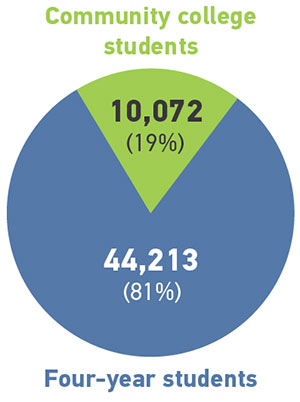Introduction and Key Findings

Introduction
Each year since 2004, the EDUCAUSE Center for Analysis and Research (ECAR) has conducted a study of undergraduate students and information technology (IT) with the goal of better understanding how students are using technology and the role it plays in their academic success. Thousands of students participate annually from more than one hundred institutions, and the results offer us the opportunity to examine student perspectives from colleges and universities big and small, public and private. While studying institutions in the aggregate offers a landscape view of students' experiences with IT, it also demonstrates that institutional contexts—such as size, type, and student characteristics—can affect technology experiences. This is especially true for community colleges, where more than a third (35% in 2017) of the more than 17 million undergraduates enrolled in Title IV institutions attend.1 Community colleges have a history of serving more diverse populations than other institutions, and with the high cost of four-year college tuition2 they provide access to an affordable education for many students. Due to the variety of people they serve and the impact these colleges have in their communities, it is important to study the perspectives of students at two-year and AA colleges. ECAR last studied student experiences through a community college lens in 2007, which in technology years is a lifetime; much has changed, and an updated report on community colleges is well overdue. This report highlights the ways community college students use, learn, and benefit from technology with regard to:
- Key demographics of the community college students in this study
- Device access, ownership, and importance to academic success
- Student success tools
- Learning environment preferences
- Accessibility
Of the 54,285 US responses included in the 2018 student study, 10,072 responses (19%) were from students from 40 community colleges3 (figure 1). Responses were analyzed to better understand their technology experiences based on key demographic factors and how some of those experiences compared with those of their peers at other types of institutions. The results summarized in this report can be used to identify and examine ways stakeholders might leverage technology to address the unique needs of community college attendees. Recognizing and attending to the varying circumstances of two-year and AA students can reveal opportunities to increase retention and credential completion, whether students stay at their community college or transfer to a four-year institution. Readers who apply these results should address the specific context of each institution based on its student population, structure, vision, and culture.

Key Findings
- Community college students are juggling more responsibilities than their four-year peers. They are older, more often employed, and twice as likely to be married or in a domestic partnership. The majority of community college students are financially independent, and they are more likely to have dependents of their own. More women than men at community colleges reported living on their own and having dependents.
- Nearly all community college students own smartphones and laptop computers, and more own desktop computers than students at other institutions. A very small percentage of community college students have access to AR/VR headsets and 3D printers; of those who do have access, more own them versus depending on their campus to provide them. Despite this limited access, more community college students than four-year students rated AR/VR headsets and 3D printers as very or extremely important to their academic success. The majority of these students were health science majors.
- Although community college students find online student success tools useful, fewer are aware of degree planning and mapping tools than four-year (non–community college) students. More than a third reported they either don't have access to or aren't aware of the tools. Significantly more minority than white students at community colleges rated early-alert systems and tools that suggest how to improve course performance as very/extremely useful.
- Community college students who are women, those who work, students who are married or in a domestic partnership, and those with dependents are all more likely to prefer learning environments that are mostly or completely online. This preference is likely due to the demands of balancing work schedules, family responsibilities, and academics. Around half of community college students prefer blended learning environments, but they are also twice as likely as four-year students to prefer courses that are completely online.
- Two-year and AA colleges are doing a significantly better job than other institutions of meeting the needs of students with disabilities who require technology for their academics. More than half of community college students with disabilities who need accessible or adaptive technology reported their college's awareness and support of their needs as good or excellent.
© 2019 EDUCAUSE. The text of this work is licensed under a Creative Commons BY-NC-ND 4.0 International License.
Gierdowski, Dana C. ECAR Study of Community College Students and Information Technology, 2019. Research report. Louisville, CO: ECAR, May 2019.
Notes
-
S. A. Ginder, J. E. Kelly-Reidand, and F. B. Mann, "Enrollment and Employees in Postsecondary Institutions, Fall 2017; and Financial Statistics and Academic Libraries, Fiscal Year 2017: First Look (Provisional Data)" (NCES 2019- 021rev), US Department of Education (Washington, DC: National Center for Education Statistics, 2018).
↩︎ -
According to data from the College Board, the average community college tuition is $3,570, compared with $9,970 at four-year colleges. See College Board, "Trends in College Pricing 2017."
↩︎ -
For the purposes of this study, community colleges were defined as institutions that (1) have the Carnegie class of AA and (2) are two-year institutions. In this study, two institutions met one or the other, but not both, of those criteria, but were included after verifying their community college status.
↩︎